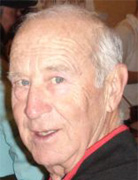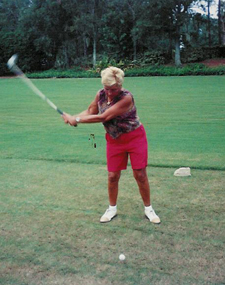|
GOLF 202
By George Schissler
Etiquette, Do and Do Not’s
of the Game
In Golf 101 we brought to you the origin of
the game and how it has evolved to become a very popular sport enjoyed by
golfers of all ages and degrees of skill.
The Tee Up
Its rapidly growing popularity demands that
participants be aware of the practices and etiquette of this gentleman’s
sport, its rules, its do’s and do not’s be fully explained. So we will
endeavor here to explain how rules came into being and what is proper and
not proper procedure while engaged in a great game of golf.
Teeing Up The Ball:  To begin the game you have to
place a tiny, wooden peg, into the ground. This is called a tee and you
place your ball atop it before striking it viciously with a club designed
solely for this purpose, but you must be careful where you place your tee.
Many players treat the placement as an exact science in the hope of where
you place the ball on the ground will result in a well struck ball which
will find an advantageous landing location in the fairway. The fairway is
usually a nice grassy, green area which affords the golfer access to the
green or putting area. At my club it is permissible to move the tee markers
a maximum of 10 yards forward when you tee off. Of course you must place
them back in their original position before leaving the tee. To begin the game you have to
place a tiny, wooden peg, into the ground. This is called a tee and you
place your ball atop it before striking it viciously with a club designed
solely for this purpose, but you must be careful where you place your tee.
Many players treat the placement as an exact science in the hope of where
you place the ball on the ground will result in a well struck ball which
will find an advantageous landing location in the fairway. The fairway is
usually a nice grassy, green area which affords the golfer access to the
green or putting area. At my club it is permissible to move the tee markers
a maximum of 10 yards forward when you tee off. Of course you must place
them back in their original position before leaving the tee.
Even before the teeing process there are certain
courtesies and rules which must be observed. Usually at the tee it is
preferred that you play with three other players and this is, for obvious
reasons, referred to as a foursome—that’s etiquette. If you happen to have a
fifth (or a pint) it is considered a courtesy to share it with the other
three members of your foursome.
Before teeing off on the first hole it is
imperative that you have no more than the allotted number of clubs in your
bag. This number varies from foursome to foursome but you will incur a two
stroke penalty (and the loss of 10 yards) if someone in your group can count
above 14.
Also when teeing up you are allowed to place
the ball within two club lengths behind the placement marker but not even
one inch in front of it. This is another 2 strokes and loss of 10 yard
penalty for the infraction of rule 103 (a) which two Scottish gentlemen put
into effect in the mid 1770’s. It has been rumored that one of them was
near-sighted and the other suffered from far-sightedness hence the 10 yards
back and one inch forward ruling came into being. The rule is still in
effect today although it was considered unnecessary after the Scotsmen
received spectacles from America’s Ben Franklin. It is also considered a
lack of etiquette to hit the ball while other members of the foursome are
engaged in conversation. It is also rumored that the American game of
football adopted and adapted the 10 yard, 1 inch rule in such a way as to
reward players for inching over the 10 yard restriction. Once they
progressed beyond the 10 yards, even by 1 inch, they renewed the process of
pressing forward down the field of play.
Local Rules
Most rules have been in effect for more
than 200 years but any golf course can invoke “local rules” which, at my
club makes the game of golf easier and more enjoyable. I don’t know the
exact wordage but one of them goes like this: “If you find a tee in the
fairway it is permissible to pick it up, proceed to your ball and put the
tee in the ground, place your ball atop the tee and then hit it”. It is a
good rule and it is amazing how quickly your game improves, not to mention
the number of tees you can amass. This is a rule golfers can live with.
Out of Bounds: Another good local rule occurs when
you hit your ball off the defined boundary of the course. If you locate your
ball and you are alone or not seen by the other players you incur no penalty
as the “out of bounds” rule no longer applies.
Lost Balls: This usually happens when you strike
the ball and it is still within the confines of the course but cannot be
found. Golfers are inclined to put a marking on their golf balls to
guarantee hitting the correct ball. but I discourage this practice as you
can without having any marking, claim whichever ball is found as being
yours. Also when a fellow golfer finds a ball in the area that you have hit
yours and asks “What did you hit?” he is trying to trick you into some kind
of admission. Do not commit to answering but instead ask “What did you
find?” In that way whatever he has found can be yours if you confidently
answer “Yup, that’s it” when he shows it to you. A definite stroke saver.
Putting Etiquette
Etiquette here on or near the putting green
is absolutely essential and will necessitate the use of your putter. The
putter is the one club that did not come with the other clubs when you
bought the clubs, and the reason for that is because it is specially
designed for use on the green. It did not come with the other clubs because
it must be specifically designed for your use. Not many golfers ever find
the correct putter, one that really works. If it does work it usually does
not work for long, which means you have to go back to the shop and shop for
a new putter. Also while on the green you must not move, converse, be in the
line of vision or do anything which might cause a distraction to the puttee.
The reason for this is obvious—YOU will be the reason the putt was missed.
It is very difficult to explain the proper putting
procedure but I will try to simplify it. First off, when the foursome
finally arrives on or near the green it must be determined who is “away” or
furthest from the hole. It is this player who will be the first to attempt
to put the ball in the hole. Even if he does not succeed in holing out the
putt he most likely will be the closest to the hole in which case he is
considered to be “in” but not in the hole. Now all the other players are
considered to be “away” and must putt their ball until they can either be
“away” or “in” in relation to the other balls on the green. If you are still
“away” you putt until you are “in” and the next person furthest “away” takes
his turn to get “in”. After several “always” become “ins” you await the two
words that bring joy to putters the world over—“that’s good” --which means
that whether you are “away” or “in” your putt is conceded and you do not
have to hole out. Immediately pick up your ball without penalty and do not
count the stroke. This also allows the long awaiting foursome behind you to
hit down on you, which is the universal signal to pick up your pace on the
next hole. (Not considered etiquette and certainly not courteous but most
times necessary). It also is a major breech of etiquette to call someone a
”putz” if he misses his putt.
The Mulligan
A mulligan is the golf term for placing a
second ball in play if you are not COMPLETELY satisfied with the initial
shot. Usually, to save time and energy, club members are allowed to ride
their cart to a location they wish to play from and place a ball which would
be termed” in play”. In this way they save time and energy by not having to
hit the second or third mulligan. Remember that from the spot where the
mulligan (whether it be the first, second or third mulligan) is struck it
must be counted as your second stroke. The logic behind this rule is
obvious. It speeds up play, increases the likelihood of finding a tee in the
fairway to aid in striking your second shot. This also helps if you are
keeping score to establish a handicap.
Handicap
This has nothing to do with health. A handicap is the
number of strokes you usually shoot over par. Par for most courses is 72
strokes. For instance if you shoot a 90 your handicap would be 18 strokes
which you would be given in an attempt to shoot par. Usually golfers only
turn in scores that add up to more than their allotted handicap so that they
would be allowed more than the 18 strokes they really play to. This is a
great way to bring down your scores—especially in club tournaments and it
has earned the term “sand bagging” a phrase that is all too familiar
throughout golf competitions although it has become a common practice.
If you follow these simple courtesies and rules you will
be amazed how your game (and scores) will quickly improve. Of course your
score might improve even more dramatically if you play all by yourself.
Those little squares on the scorecard were purposely made small so as not to
accommodate double figures.
HELPFUL HINT:
When renting a golf cart always ask to take it for a
trial spin. You want a cart which can outrun your competitor’s machine for
this reason—He who has the fastest cart NEVER has a bad lie!
|